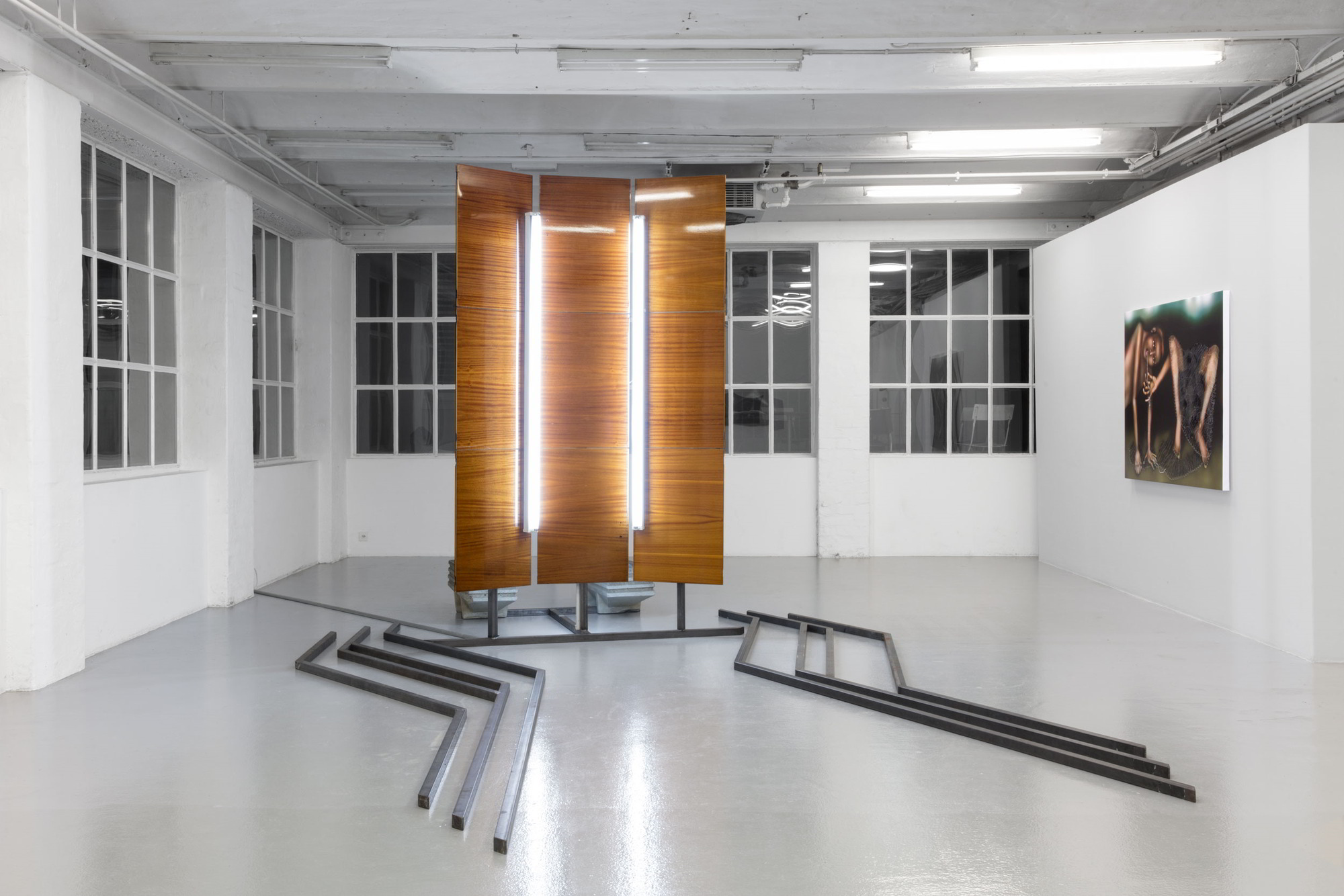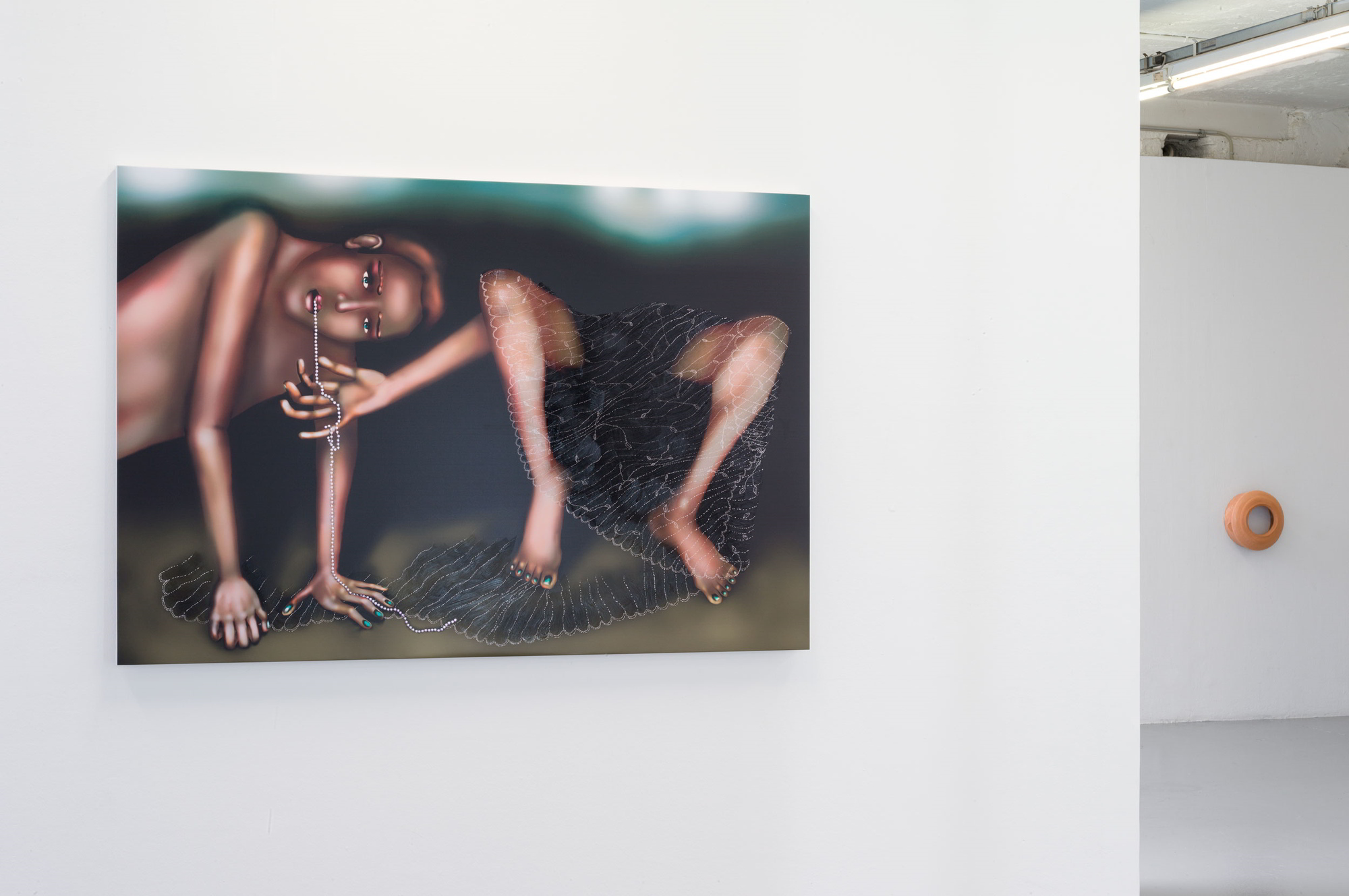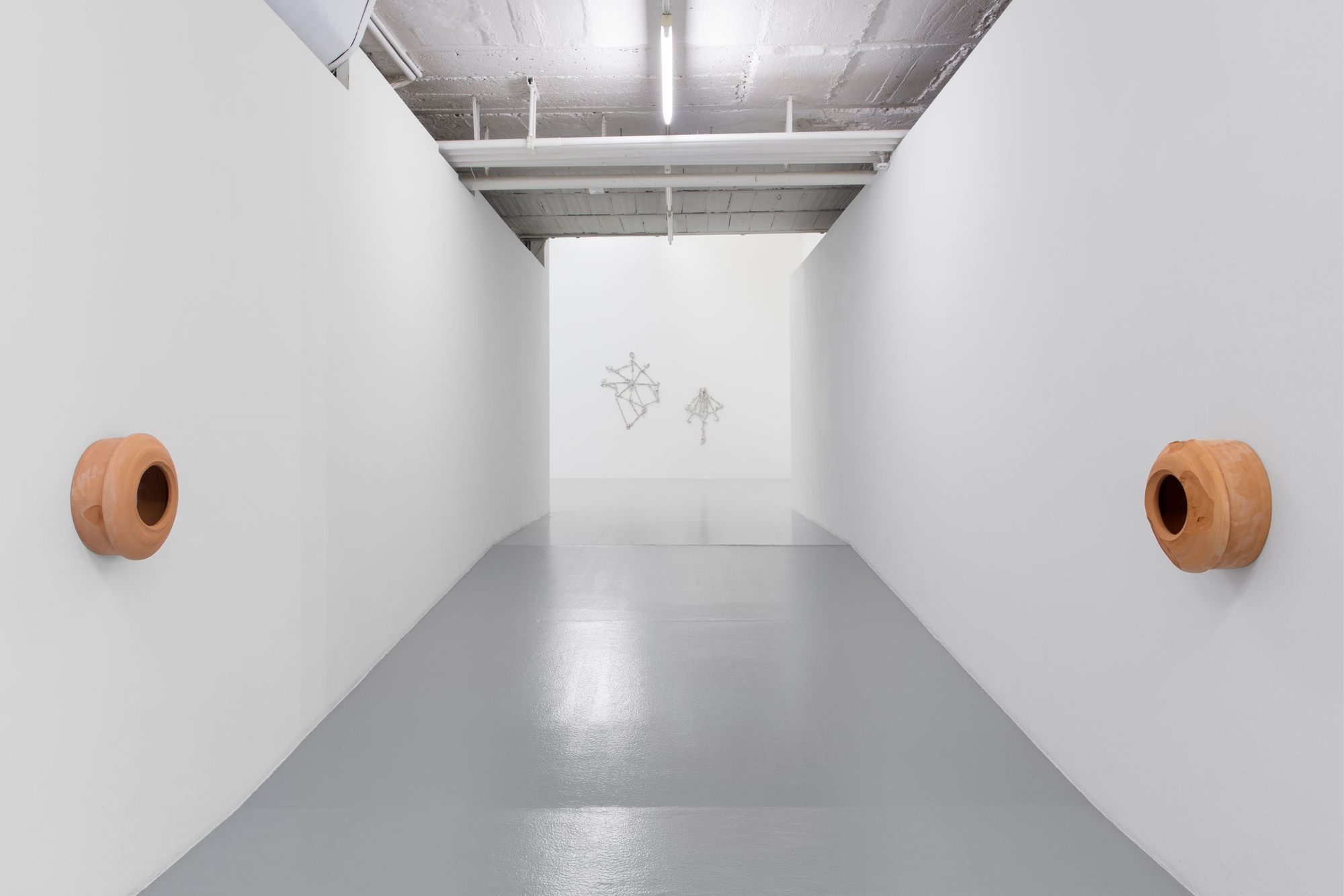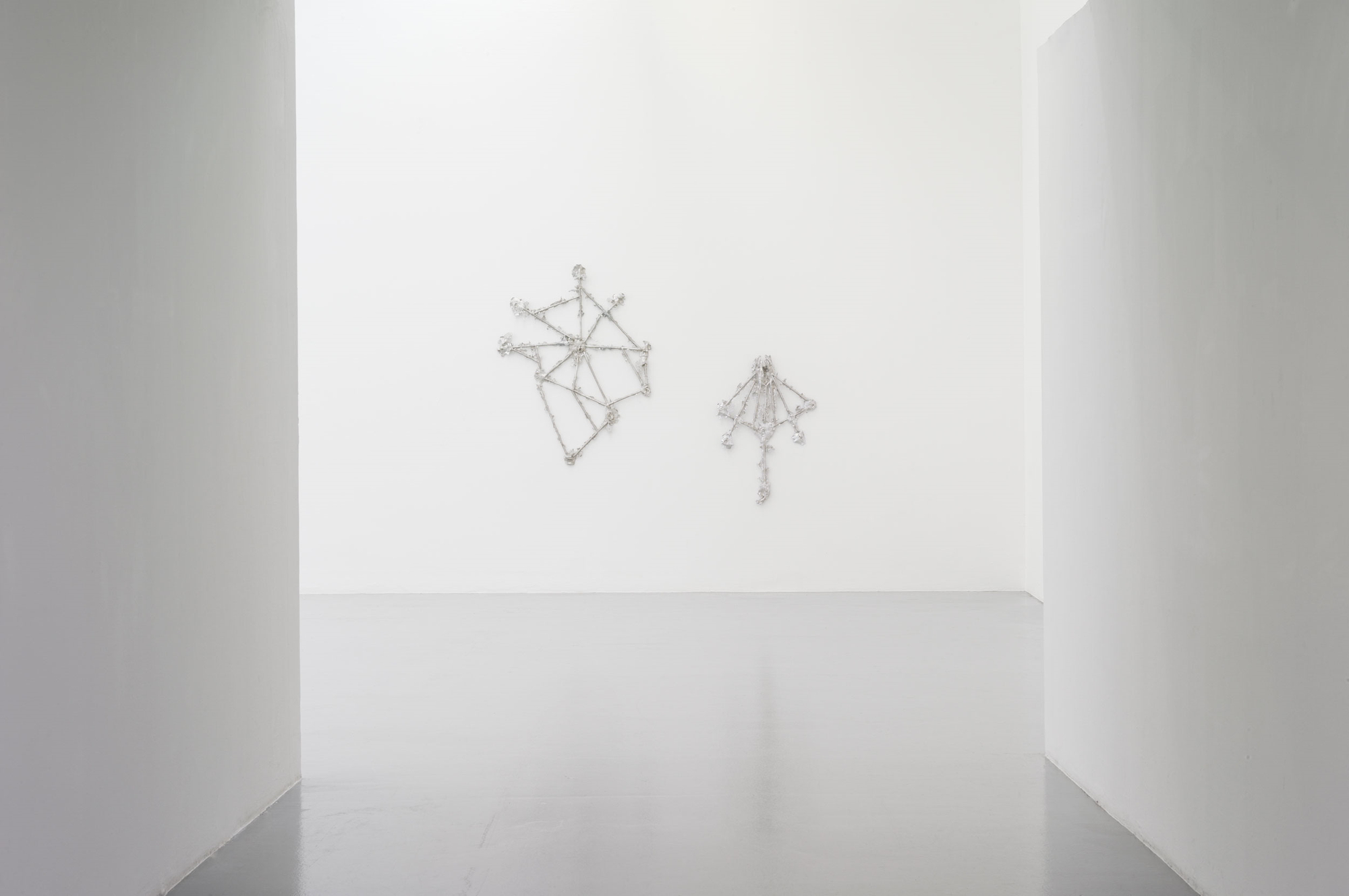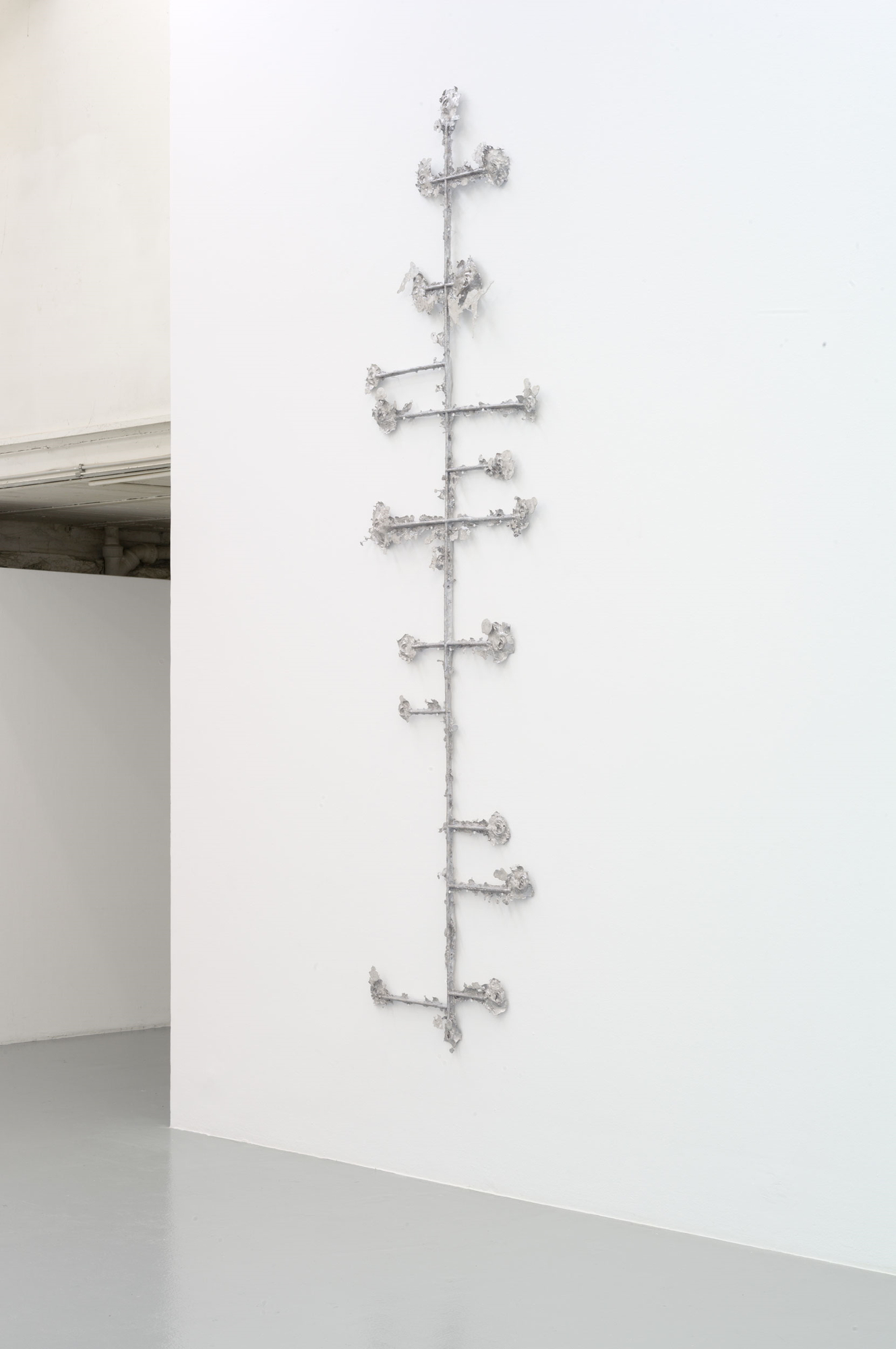Artists: Louisa Gagliardi, Adrian Kiss, Sara Masüger
Exhibition title: Tronc Mental
Venue: CAN Centre d’Art Neuchâtel, Neuchâtel, Switzerland
Date: March 10 – April 15, 2018
Photography: Anton Satus / all images copyright and courtesy of the artists and CAN Centre d’Art Neuchâtel
CAN, the Centre d’art, Neuchâtel, is pleased to present the work of Louisa Gagliardi, Adrian Kiss, and Sara Masüger. While each of these three artists has a sharply defined personal world that is quite distinct from the others’, they and their work give rise to multiple dialogues. Gagliardi and Kiss, for example, can be grouped under the banner of the Postinternet generation of artists. What binds them is their way of evoking the question of the body, its representation and its connection with its present environment. Their artworks also reveal similarities in the ways they marshal certain materials, conceive of the light and the lighting of the venue, and finally use certain ranges of color, Gagliardi in work that is directly linked with representation, and Kiss through his sculpture and installation practices. Both also reference the digital world that now surrounds all of us and in which they were born. Sara Masüger, on the other hand, comes from a slightly older generation. Her sculptures are basically fashioned from molds done from human body parts which she produces within a framework of conceptual and performance protocols. Yet her working methods, which mix more classic techniques with more contemporary attitudes, and her way of approaching the body today, i.e., straight on and quite obviously deliberate, resonate in an interesting way with the works of Louisa Gagliardi and Adrian Kiss.
Louisa Gagliardi
Louisa Gagliardi is a young artist from Valais born in 1989. She lives and works in Zurich. Gagliardi began her career as a graphic designer. Her work was quickly noticed and garnered a federal grant in 2015. At that time she begins to draw sorts of figurative digital paintings on her computer. The few images she posted on the internet were rapidly spotted and she found herself suddenly offered a number of exhibitions in well-established venues for contemporary art. Gagliardi’s painting is representative of certain trends currently running through contemporary art whor-evisit the figurative art of the early 20th century. Gagliardi paints portraits, of men smoking, nudes, group scenes that recall German Expressionism not only for her choice of subjects but also for their workmanship. This connection, this return to a bygone period of art history, is counterbalanced by a grounding in our contempo-rary reality that is equally emphasized. Gagliardi’s work springs directly from cur-rent digital tools. The artist’s images are realized thanks to software programs like Photoshop, then printed on plastic canvases. She later adds elements directly to the supports using a brush. The computer tools generate specific treatments, be it in the way the image’s depth is rendered, or in terms of the colors, which are quite different from those found in traditional painting. The artist’s recent works mainly feature people in groups. The bodies are naked, the figures doing simple minimalist actions like carrying a bundle or handling jewelry. Their genitals are often hidden and in several scenes they are simply not depicted at all, leaving the question open in the end as to the figures’ gender. Gagliardi’s bodies seem to freely move about in dreamlike spaces that are both magical and infused with anxiety.
The artist’s world is a space that is flooded with cold artificial light that has a whiff of the digital about it. The spaces seem confining, indistinct; they convey not natural places but rather inte-rior ones that are formless and vague. It is here that the reference to Expressionism is utterly surpassed. Gagliardi depicts a digital world devoid of natural reference, a completely abstract place. As indistinct and unnatural as the settings, the bodies that are stripped of their sexual organs and given similar, undifferentiated traits, seem to void any naturalist discourse, any Romantic idea, and rather evoke the concept of a body plunged into a futurist present where it has the freedom to shake off all the cultural codes to which it feels it has been confined up to that point.
Adrian Kiss
Born in 1990 in Romania, Adrian Kiss studied at the prestigious Saint Martin’s School in London. Newly graduated, he returned to settle in Eastern Europe, in Budapest in fact. Among the artist’s recent works, Seat Hole 1 and 2 are characteristic of his approach. The pieces feature human torsos shaped from black or brown leather which are pierced through the shoulders by a cable which makes it possible for them to be displayed floating in the exhibition venue. Pot-sherds are attached to the torsos’ lower region and the point where they are installed brings to mind genitalia. Improbable and surreal, this combination of materials and unthinkable forms reveals first of all the daring and the imagination of this young artist. The leather shapes are half-human body half-automobile seats, and the strange sexual organs indicated by the pottery, a kind of ancient fragile orifice, render the question of their gender mysterious and indecisive. Kiss positions sexuality as one of the driving subjects of his output. As in Gagliardi’s paintings, the body is no longer the type that usually gets depicted, that is, it isn’t gendered, or is but in an ambiguous way; it is above all mutant, cold and liberated, disturbing and joyous, and linked to the objects and environments surrounding it in a powerful and inventive way.
Kiss’s large installations like Sylvania and Altar can be seen as architectural machines that immediately introduce a relationship with the viewer’s body. Their surfaces sprout neon lights, which, in addition to their power as graphic elements, enable the works to propagate through-out the space, contaminate it, and wrap the viewer in a halo of light. The pieces, too, can be understood as bodies, customized trunks that are extended with metal legs, or as oversized members that have been erected as futurist totems. These formalist installations certainly recall Hungarian modernism with its sharp-angled, extremely structured forms. Kiss does not deny these parallels but he does like to emphasize more modest references that are more in keeping with the applied arts, like fashion and graphic design.
Sara Masüger
The work of the Swiss artist Sara Masüger mainly involves casts she makes of various parts of her body. The technical difficulties imposed by her method lie at the heart of her art-making. Constrained by her own physical limitations, the artist is led to play off the acci-dents and incidents the situation generates. To produce her tin sculptures, the artist first makes castings of her own body, then uses those to obtain wax pieces. Next she creates a second mold. That mold is shaped around several wax pieces, which she arranges so as to form compositions that are sometimes symmetrical and sometimes not. Mäsuger proceeds to build channels between the pieces which will allow her, after the work is removed from the mold, to keep its individual parts together. Besides this function, the channels are also a way for the artist to create lines and curves, and to depict geometrical structures in space.
Masüger’s work is made up of contrasts and paradoxes. The delicacy and formal complex-ity of human organs and members are contrasted with the violent and rough nature of metalworking. Her assemblages evince the singularity and intimacy of the human body as much as the distance and coldness of serial production.
The artist reminds us that our bodies are at the forefront of important transformations, that they will increasingly be coupled with, extended, and heightened through implants, artificial parts, and interfaces. Likewise, when we find ourselves standing before her works, it is hard not to think of the production of robots, which has continued to accelerate in recent years. The future now being built in factories and labs has its dark side; these are the kinds of ideas that come to mind when the eye alights on the imperfections and malforma-tions that take shape from the way Sara Masüger works. We might be led to think that the artist is having a bit of fun creating works that mime industrial failures, like those defective products that factories sometimes hide in their backyards, leaning against a wall, abandoned
Adrian Kiss “Sylvania”, Louisa Gagliardi “Spitting Pearls” ,Tronc Mental, Centre d’art Neuchâtel, CAN, 2018
Adrian Kiss “Sylvania”, Tronc Mental, Centre d’art Neuchâtel, CAN, 2018
Louisa Gagliardi “Spitting Pearls », Adrian Kiss “Large peanuts », Tronc Mental, Centre d’art Neuchâtel, CAN, 2018
Louisa Gagliardi “Spitting Pearls », Tronc Mental, Centre d’art Neuchâtel, CAN, 2018
Tronc Mental, Centre d’art Neuchâtel, CAN, 2018
Adrian Kiss, “Seat hole 1” and “Seat hole 2” , Tronc Mental, Centre d’art Neuchâtel, CAN, 2018
Tronc Mental, Centre d’art Neuchâtel, CAN, 2018
Tronc Mental, Centre d’art Neuchâtel, CAN, 2018
Louisa Gagliardi “Living downstream” , Tronc Mental, Centre d’art Neuchâtel, CAN, 2018
Adrian Kiss “Active Rail 3”, Louisa Gagliardi “Electric Sleep” ,Tronc Mental, Centre d’art Neuchâtel, CAN, 2018
Louisa Gagliardi “Electric Sleep” ,Tronc Mental, Centre d’art Neuchâtel, CAN, 2018
Louisa Gagliardi “Spilling Lilies”, Adrian Kiss “Active Rail 3”, Tronc Mental, Centre d’art Neuchâtel, CAN, 2018
Louisa Gagliardi “Spilling Lilies”, Tronc Mental, Centre d’art Neuchâtel, CAN, 2018
Tronc Mental, Adrian Kiss “Large peanuts”, Sara Masüger “Untitled” and “Untitled”, Centre d’art Neuchâtel, CAN, 2018
Sara Masüger “Untitled”, “Untitled”, Tronc Mental, Centre d’art Neuchâtel, CAN, 2018
Sara Masüger “Untitled”, Tronc Mental, Centre d’art Neuchâtel, CAN, 2018
Sara Masüger “Untitled” (detail), Tronc Mental, Centre d’art Neuchâtel, CAN, 2018
Sara Masüger “Untitled”, Tronc Mental, Centre d’art Neuchâtel, CAN, 2018
Sara Masüger “Untitled” (detail), Tronc Mental, Centre d’art Neuchâtel, CAN, 2018
Sara Masüger “Untitled”, Adrian Kiss “Y Gate”, “Altar”, Tronc Mental, Centre d’art Neuchâtel, CAN, 2018
Sara Masüger “Untitled”, Adrian Kiss “Y Gate”, Tronc Mental, Centre d’art Neuchâtel, CAN, 2018
Sara Masüger “Untitled”, Tronc Mental, Centre d’art Neuchâtel, CAN, 2018
Adrian Kiss “Altar”, Tronc Mental, Centre d’art Neuchâtel, CAN, 2018
Sara Masüger “Untitled”, “Untitled”, “Untitled”, Tronc Mental, Centre d’art Neuchâtel, CAN, 2018
Sara Masüger “Untitled”, Tronc Mental, Centre d’art Neuchâtel, CAN, 2018
Sara Masüger “Untitled”, Tronc Mental, Centre d’art Neuchâtel, CAN, 2018
Sara Masüger “Untitled” (detail), Tronc Mental, Centre d’art Neuchâtel, CAN, 2018
Tronc Mental, Centre d’art Neuchâtel, CAN, 2018
Sara Masüger “Untitled”, “Untitled”, “Untitled”, Tronc Mental, Centre d’art Neuchâtel, CAN, 2018
Tronc Mental, Centre d’art Neuchâtel, CAN, 2018
Sara Masüger “Untitled” , Tronc Mental, Centre d’art Neuchâtel, CAN, 2018
Sara Masüger “Untitled” (detail), Tronc Mental, Centre d’art Neuchâtel, CAN, 2018
Adrian Kiss, Tronc Mental, Centre d’art Neuchâtel, CAN, 2018


